A few weeks ago I noticed an advert on A Softer World that looked like this:

If there was ever an ad crafted to attract my attention, it was that: the “interesting” caught my eye, the “$1/Day” pulled me in, the tiny graphics sealed the deal.
So I clicked, and ended up at the Box Bot which describes itself like this:
Bobcat In A Box is an automated program (or a “bot”) that sends you lots of little packages, bought from eBay and other sites across the internet with free shipping. It buys you at least one package every day. You can give the bot instructions as to what sort of packages you want, for example to only buy beads or postcards or anime items, or you can have it buy completely random packages and let the bot surprise you!
Right. Up. My. Alley.
How could I not sign up?
So I did. In Catherine’s name, as she’s a art practice that can profit from a random scatterling of interesting ephemera. I specified the keywords “fabric, wool, knitting, fibre, postcards, flags.”
And, yesterday, the first package arrived. From China. Four pieces of fabric, nicely swaddled in cellophane wrap.

“How is this possible?” is the first question that comes to mind: it’s hard to conceive of what economic model allows the cost of the product, the labour to assemble and ship it, and the shipping costs to come to less than $1 and still leave room for profit. The Box Bot FAQ addresses this unsatisfyingly:
How do the merchants make money on $1 items with free shipping?
The short answer is that I don’t know. For many of the items, merchants are certainly selling at a loss. But there are lots of sellers, on eBay and other online platforms, who keep offering items for next to nothing with free shipping….so the bot will keep buying them! As most of the items are shipped from Asia, many of the merchants pay several dollars for “free shipping”. A good number of the items bought by the bot will have “Shipping: $5” or something similar printed on the custom form! Even though the cost to ship is several times the winning bid, merchants fulfill the order and ship the items the bot buys. Perhaps they have a discounted shipping deal that makes it worthwhile. It is something of a mystery as to why they offer the items for such low prices on eBay, as it is easy to set a reserve price or start the auction at a higher bid. Perhaps the merchants ship these small items to boost their feedback scores or hope that they will be bundled with other purchases.
So the “how” remains a mystery. But it works. And I can’t wait to see what comes next
Longtime readers will recall that 4 years ago I related the story of how L.L. Bean exchanged my 5 year old winter jacket with a broken zipper for a brand new winter jacket (and an $86 windfall).
That replacement jacket served me well: it had an almost-idea combination of multiple pockets, warmth and longevity that I hoped it would be my winter jacket forever.
That was until it started to experience zipper problems of its own last month: gradually worsening over time, the zipper stopped zipping up effectively, so that I’d find myself walking in -30ºC weather and my zipper would suddenly zip open. By last week I was batting 25% on a successful zip-up, spending 3 or 4 minutes every time I wanted to go outside trying to find the magic trick that would make the zipper stick.
As it happened, I was in New England last week again, driving right by the selfsame L.L. Bean Wayside Commons. In anticipation I returned again to the 100% Guarantee page on the L.L. Bean website and found the committment stands:
Our products are guaranteed to give 100% satisfaction in every way. Return anything purchased from us at any time if it proves otherwise. We do not want you to have anything from L.L.Bean that is not completely satisfactory.
 So on Friday afternoon, en route from Yankee Publishing to Boston Logan Airport, I took exit 33A from Rte. 128 north and found myself, 4 years later, again looking to exchange my L.L. Bean winter jacket.
So on Friday afternoon, en route from Yankee Publishing to Boston Logan Airport, I took exit 33A from Rte. 128 north and found myself, 4 years later, again looking to exchange my L.L. Bean winter jacket.
Much has changed, it seems, in the world of winter jackets since 2011: puffy down-filled jackets are in, and ones like my trusty Bigelow are not. So it took a lot of sorting through the jacket stock to find something that would suit.
Ironically, I ended up with the same coat, the Weather Challenger, that I started with almost a decade ago. It retails for $199 these days, and my Bigelow originally retailed for $149, so I ended up with a new jacket for $50.
At no point in the exchange process was I made to feel as if I was doing anything unusual, leading me to be believe that not only does L.L. Bean stand behind its products, but that they communicate this to their employees to the extent that everyone internalizes it.
So a tip of the hat to L.L. Bean and the friendly staff at Wayside Commons: I’m warm and well-zippered yet again.
I’ve been archiving Prince Edward Island electricity load and generation data for more than 2 years now, but to date the only way of visualizing that data was a confusing graph. A graph that loads really slowly – or not at all – on mobile devices. And so I found my “peripheral aggregate electricity awareness” sinking.
So in an effort to scratch this itch, I coded up a small single-purpose mobile-friendly website yesterday, http://pei.consuming.ca/, that looks like this:
![]()
The website tells you three things: what the total electricity load on Prince Edward Island is right now (“how much electricity we’re all using”), how much of that load is being met by wind-energy generation, and what percentage of the load the wind represents.
In the screen shot above, taken this morning at 8:30 a.m., the load is high at 232 MW (peak load on PEI is 268 MW) and only a small fraction of that load, 11 MW or 5%, is being met by the wind (the remainder is coming from local fossil fuel generation and over the submarine cable from New Brunswick). Both the load and the wind were lower than the last report, which is why the light grey arrows are both point downward.
You should be able to load up http://pei.consuming.ca/ in any relatively modern mobile or desktop browser: the chart is drawn with jCanvas and the site uses the jQuery Mobile framework.
Here’s a summary of all of our metered consumption for 2014. The electricity, heating oil (furnace, domestic hot water) and water are for the 2048 square foot house that Catherine, Oliver and I live in. The gasoline is for our 2000 Jetta and various rental cars. What isn’t included is gasoline used for business, or consumption in my office or Catherine’s studio.
| Energy | Supplier | Consumption | Cost |
|---|---|---|---|
| Electricity | Maritime Electric | 5,518 kWh | $1,117.69 |
| Heating Oil | Coop Energy | 3,710 litres | $4,344.10 |
| Gasoline | Various | Unknown | $868.77 |
| Water | Charlottetown Water & Sewer | 128,000 litres | $408.73 |
Compiling this information was easy, as all of our bills are now sent electronically, and so I have them archived in Evernote (gasoline was the exception: I had to hunt through my MasterCard bills for gasoline purchases).
About a month ago I received an invitation, under the aegis of my role as Hacker in Residence, Robertson Library, to a meeting in the library with the team working on publishing the ebook and audiobooks versions of author H. Wade MacLauchlan’s biography Alex B. Campbell: The Prince Edward Island Premier Who Rocked The Cradle. While the printed book was published by the PEI Museum and Heritage Foundation, the library had taken on the digital publishing task, with the proceeds from digital sales generously directed towards the library’s digitization program.
By the time I joined the effort all of the heavy lifting of the digital project – recording the audiobook, preparing the EPUB, and building a website to sell them – was done, and so my contributions consisted primarily of making pithy comments like “why are you charging in the first place, man: information wants to be free.”
Okay, I didn’t actually say that. At least I didn’t say it like that.
But my arguments fell on deaf ears and the capitalist impulse, or at least the enlightened capitalist impulse, won the day, and so I latched onto a tiny offshoot of the project: getting the digital books into the various proprietary platforms – Google Play Books, iBooks, Kindle, Audible – where they might attract a broader audience.
So I started the project being a defender of information’s right to be free and then became one of its jailers. Irony noted.
What has followed, over the past month, has been a fascinating deep dive into the arcane world of digital publishing: EPUB formats, metadata, bank accounts, asserting rights ownership. The whole exercise nearly came crashing to a halt when the intractable finance department at UPEI refused to allow its bank account to be the repository for funds from Apple et al. But I was able to route around all intractability, institutional and technical, and so I am happy to say that you can now purchase the Alex Campbell biography at fine digital stores everywhere, worldwide:
- Amazon.ca Kindle (Canada):
- Amazon.com Kindle (USA)
- Amazon.co.uk Kindle (UK):
- Google Play Books
- Google Books
- Apple iBooks
On the Kindle and Google Play what you’ll purchase is a handcrafted EPUB that I stitched together from an InDesign HTML export; this is a “reflowable” EPUB, with endnote references linked to the endnotes, that works equally well on phones, tablets and on the desktop. The Apple version is a straight non-reflowable EPUB that came right out of InDesign; I’m working on upgrading this to a more flexible format.
As to the audiobook, that’s the next frontier: what I discovered is that Audible.com own the audiobook marketplace, at least in North America: if you want your audiobook on Audible, iTunes and Google Play, you need to get the book on Audible, and to get on Audible requires a U.S. address, a U.S. bank account, and following some strict audio format guidelines. I’ve cracked the address and banking questions; the audio formatting will get underway next week.
In the meantime, you can purchase the audiobooks – and, indeed, the ebook – directly from the library, where the library keeps 100% of proceeds rather than the crumbs that the multinationals pass on: just visit AlexBCampbell.com.
As I reported yesterday, January 1, 1975 was the first year that women were welcomed, albeit somewhat grudgingly, at the annual New Year’s Day levee at Government House in Charlottetown.
But that wasn’t how the story began: here’s the front page of The Guardian from December 10, 1974, with the headline “Governor Bars Women From New Year’s Levee”:
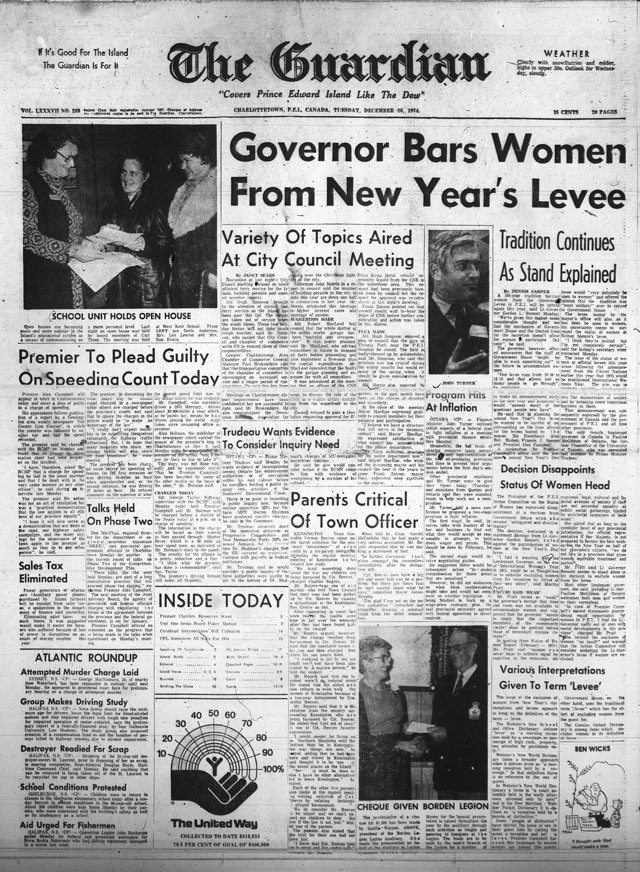
Under that headline there were three stories, under the sub-heads “Tradition Continues As Stand Explained,” “Decision Disappoints Status Of Women Head” and “Various Interpretations Given To Term ‘Levee’ ”:
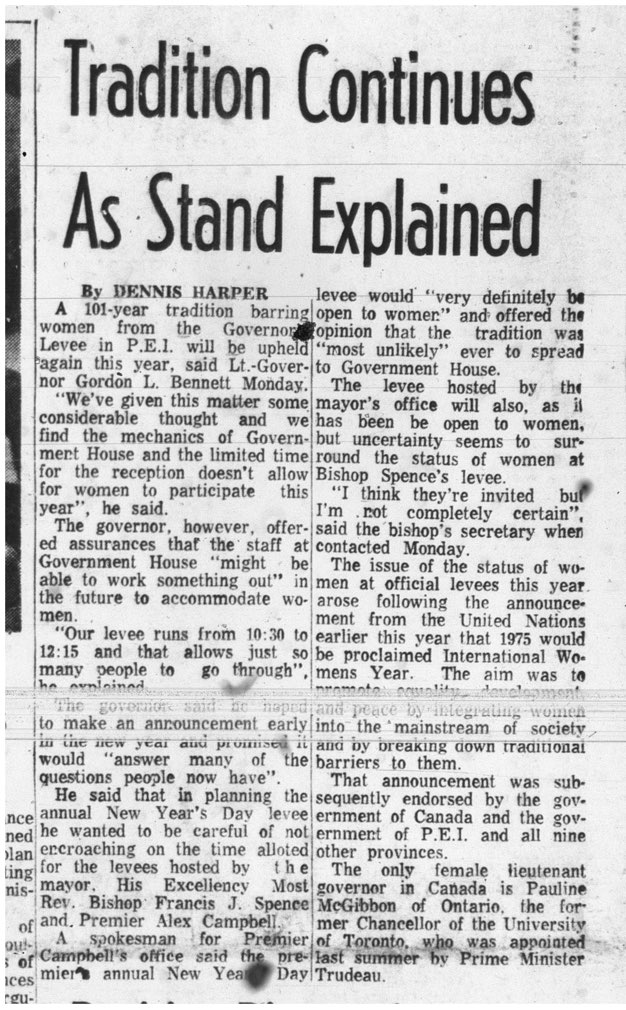
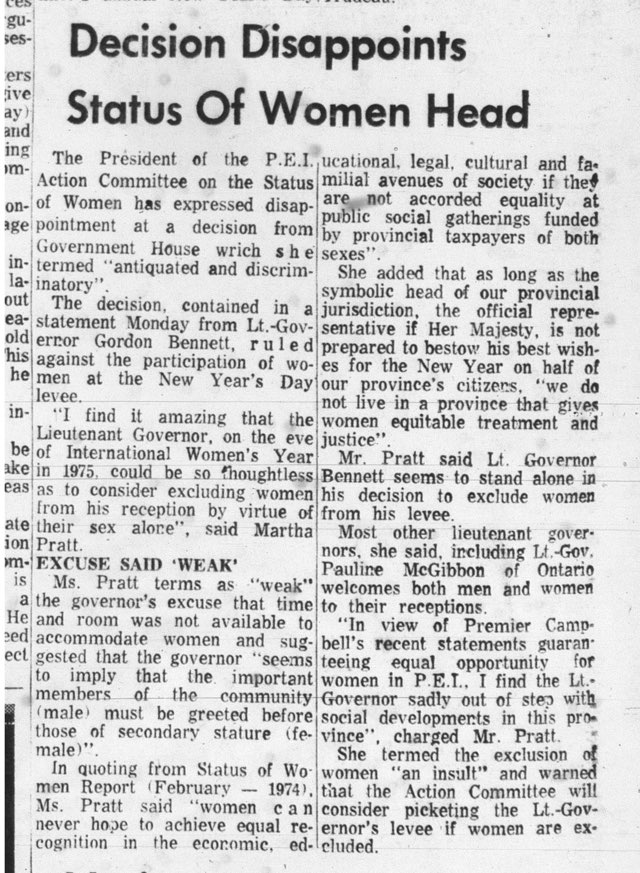
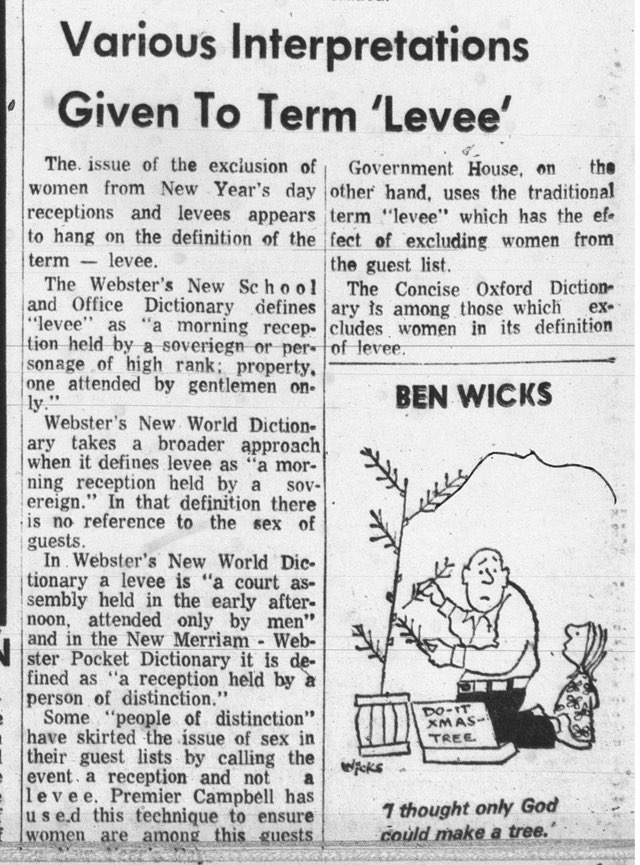
To its credit, The Guardian ran an editorial in the same issue headed “Change Due,” and calling the ban on its blatant sexism: “Granted, time may be limited for the reception, but since it is a ‘hello’ and ‘goodbye’ affairs of persons meeting His Honor what has ‘mechanics” got to do with the sex of a person?”:

More rational heads obviously prevailed, as the next day’s paper updated the story: “Women Not Barred at Governor’s Levee”:
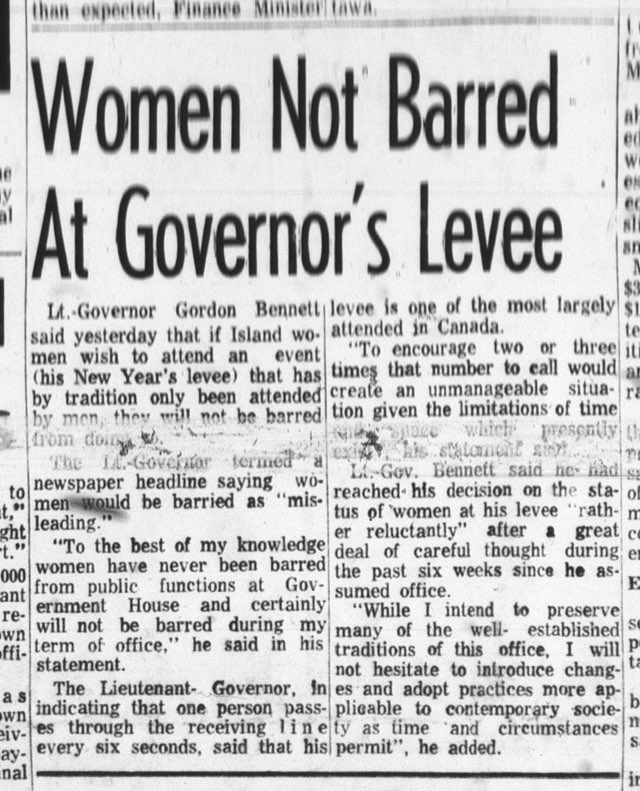
Later that month, as January 1, 1975 approached, The Guardian comments on the busy levee schedule, with four levees – Lieutenant Governor’s, Mayor’s, Premier’s and Bishop’s – scheduled for New Year’s Day:
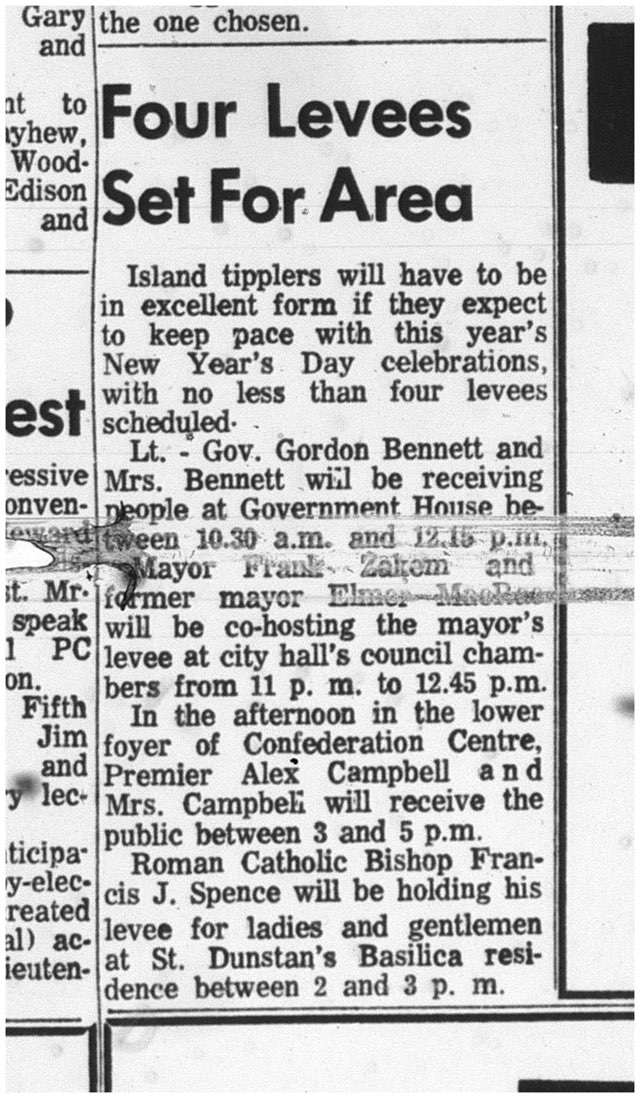
The advertisement in the newspaper for Premier Alex Campbell’s levee made a point of specifying “Both ladies and genlemen [sic] will be received,” and avoided, presumably for reasons of not limiting women, the term “levee” altogether in favour of “receiption”:
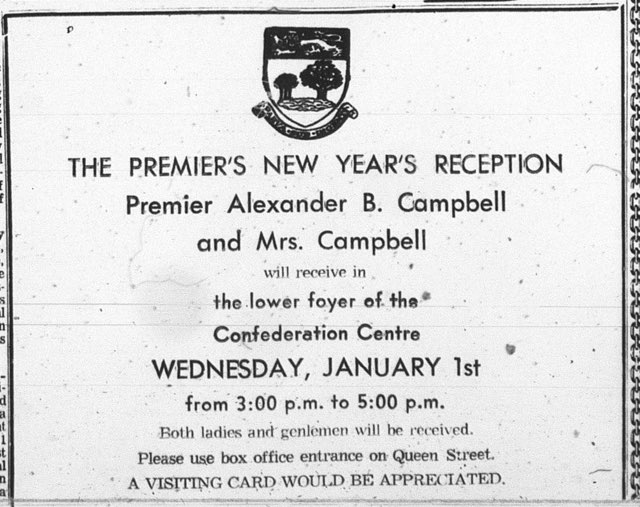
Meanwhile, while not specifically excluding women, neither the Mayor nor the Lieutenant Government specifically welcomed women either:
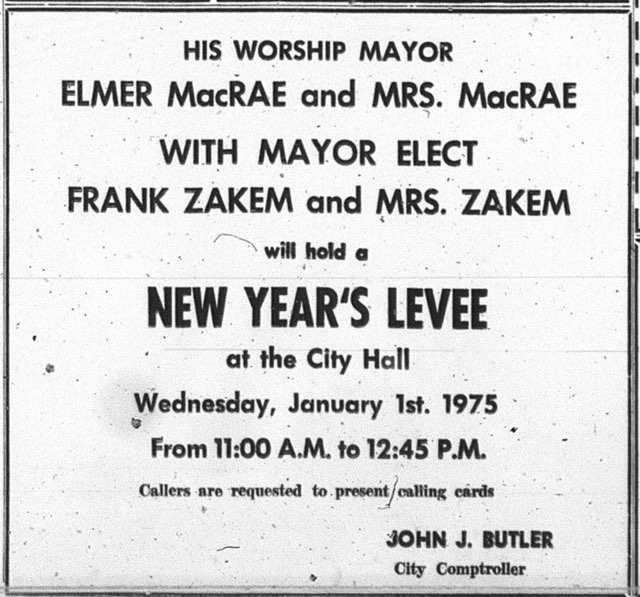
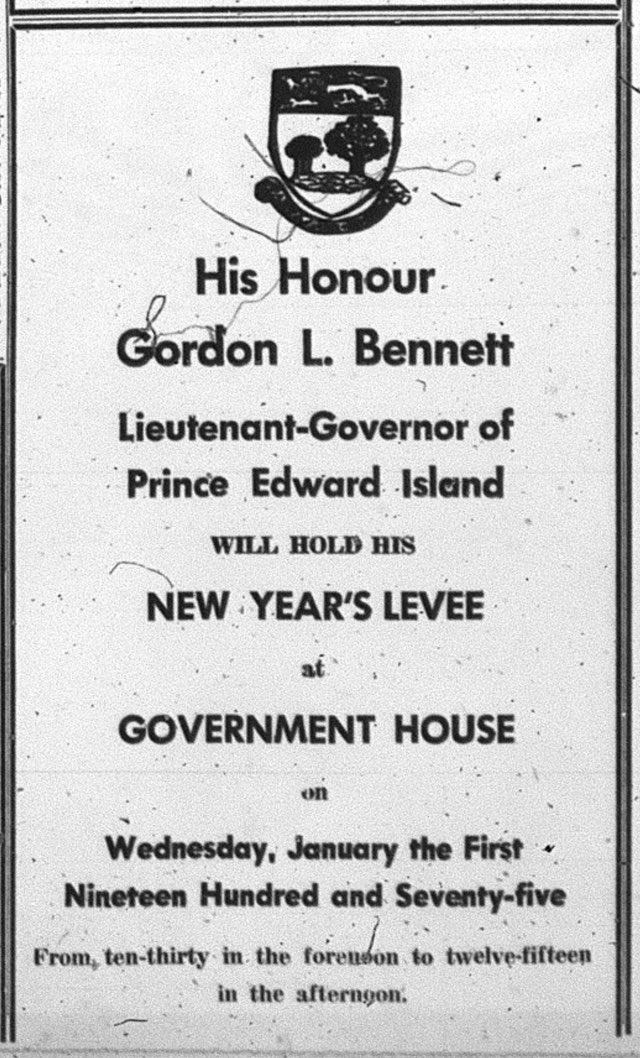
Another reminder that all are welcome at all levees, 40 years on from 1975. Find the schedule for 2015 here and I’ll see you there.
Wade MacLauchlan reports in his biography of Alex B. Campbell that January 1, 1975 – 40 years ago next week – was the first occasion that women were permitted to attend the Lieutenant Governor’s levee, and only grudgingly at that:
One of the most visible changes came on January 1, 1975. The United Nations’ International Women’s Year was ushered in on PEI with women participating in the traditional lieutenant-governor’s levee at Government House for the first time. This came about in a way that was typical of many of the breakthroughs made by women during the period. Lieutenant-Governor Gordon Bennett had only been in office a few weeks, and had initially indicated in response to media queries that there would be no change in the format of the levee for 1975, meaning that it would be “men only.” The justification offered was that “the mechanics of Government House and the limited time for the reception” made it impossible to accommodate women, although the possibility was left open that something could be worked out in the future.
Two days later, Lieutenant-Governor Bennett issued a statement signalling that women would be permitted to attend the levee and protesting that women had never been barred from Government House, declaring “While I intend to preserve many of the well-established traditions of this office, I will not hesitate to introduce changes and adopt practices more applicable to contemporary society as time and circumstances permit.” Cabinet minister Catherine Callbeck was one of a group of twenty-five women who joined almost one thousand men at Government House on January 1. Gaining admission to the levee was symbolic. Women had been attending the premier’s New Year’s levee throughout Alex Campbell’s time in office, continuing a practice begun in the later years of Walter Shaw’s premiership.
While I don’t think celebrating this fact is in order – should we really be celebrating the fact that in my lifetime such an indefensible, sexist policy was still in place – it is an anniversary worthy of marking.
Everyone – actually everyone – is welcome at every levee that’s on my annual Charlottetown Area Levee Schedule and I encourage you to all attend on January 1, 2015.
My in-laws are visiting us, and my father-in-law is a dedicated newspaper reader, so I was prompted me to take out a subscription to The Guardian, Prince Edward Island’s newspaper of record, for the next while.
There’s no way to subscribe only to the printed newspaper: the standard $17.50/month subscription includes daily home delivery of the print newspaper along with the “e-edition” and all-you-can-eat access to the otherwise-metered website. Oddly, the price for this without the printed newspaper is exactly the same. Which doesn’t bode well for print, as it suggests that the print newspaper is deemed to be worth $0.
The first copy of the newspaper arrived this morning (impressive, given that I purchased my subscription only yesterday) and included an excellent cover story on government expenses reported by Teresa Wright and Ryan Ross. It was a good issue to start a subscription with.
Meanwhile, I decided to use my newly-unlocked access to the entire Guardian website as an opportunity to try and make it less confusing to read (I found, to my surprise, that unlocking the website with a subscription doesn’t make any of the ads, offers and extraneous elements go away).
Hence this Greasemonkey user script:
// ==UserScript==
// @name cleanup-pei-guardian
// @namespace peter@rukavina.net
// @include http://www.theguardian.pe.ca/*
// @description Hides the annoying parts of The Guardian website.
// @version 1
// @require http://ajax.googleapis.com/ajax/libs/jquery/2.1.0/jquery.min.js
// @grant GM_addStyle
// ==/UserScript==
$('#scpc_top_banner').hide();
$('.ad-wrapper').hide();
$('#user-elements').hide();
$('#featured').hide();
$('.promospace').hide();
$('.featured-box').hide();
$('aside').hide();
$('footer').hide();
$('.slider-box').hide();
$('footer').hide();
This script, once installed in Greasemoney, has the effect of turning this:

into this:

The effect is dramatic, and reading the altered version makes me feel like I can breathe again. And it makes me feel like I’d actually like to spend some time exploring the website.
I realize the irony of this experiment, as the bulk of my living derives, directly or indirectly, from web advertising revenue that appears in ways that are often as jarring as on The Guardian. The difference, though, is that I’m paying The Guardian $17.50 and the least they could do is make the experience of reading the website slightly less annoying.
It’s worth remembering that The Guardian has more than 100 years of a history of using design non-annoyingly; witness the front page of the print newspaper from today’s date in 1939:

It is a thing of beauty.
I spent the afternoon printing a new round of gift certificates for Casa Mia Café, to feed the demand for the holidays. They’ll be on sale as soon as the ink is dry.
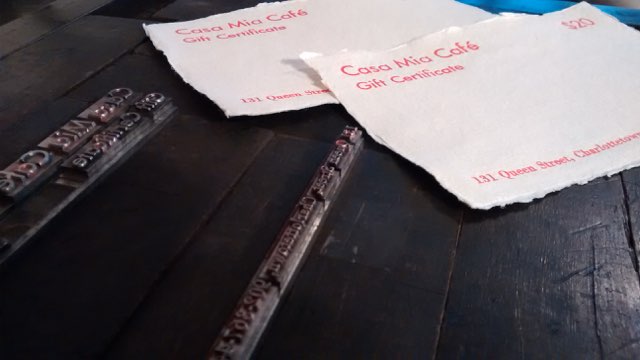
They are printed on Indian cotton rag paper from Khadi Papers on my now-99-year-old Golding Jobber № 8 letterpress in Futura 30 pt. and 24 pt. and Bodini 14 pt. They’re available in $20 and $50 denominations.
I have become diverted by an interest in the history of time on Prince Edward Island. To this end, ably aided by Simon Lloyd at Robertson Library, I have begun to explore the relevant legislation.
Here, for example, is a snippet from The Interpretation Act of 1939:

Let’s do some checking on the math.
There are 360 degrees of longitude, and 24 hours in a day, so each degree of longitude represents 4 minutes of time.
That means the a difference in time of 12 minutes and 29 seconds, which is the figure in the Act for the difference between the Provincial Clock in Charlottetown and 60 degrees west, would be 3.125 degrees of longitude.
Which, in theory, places the Provincial Clock at 63.125 degrees west.
And, sure enough, if I go to OpenStreetMap.org and navigate to the Coles Building – the contemporary name for the Law Courts Building – it is, indeed, at -63.125º.
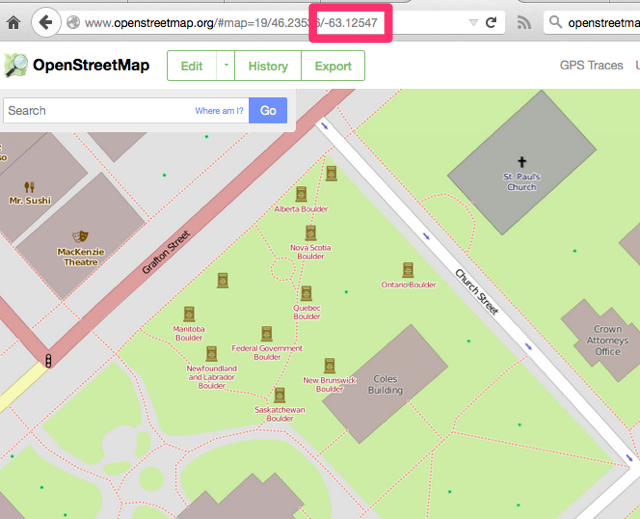
You can see this better-illustrated on the Atlas of Canada, with the NTS grid (National Topographic System) turned on. The major divisions on the NTS grid are spaced at 2º of longitude apart, and the minor divisions are spaced at 0.5º of longitude, so moving 3.125º east of Charlottetown you reach 60º west, which runs through the tip of Cape Breton:

Another approach to this would be to compare the time of the sunrise in Charlottetown to the time of the sunrise in Glace Bay, Nova Scotia (which sits almost right on top of the 60th meridian). And sure enough, the sun rose in Glace Bay this morning at 7:36 a.m. and in here in Charlottetown at 7:49 a.m., 13 minutes later.
Or, like The Interpretation Act says, 12 minutes and 29 seconds later.
The time in the Atlantic Time Zone is based on the time at the 60th meridian, which is interesting to note because that meridian runs along the very eastern side of the time zone’s boundaries. This means that although they are in the same time zone, though the sun rose today at 7:36 a.m. in Glace Bay, it didn’t rise until almost a half hour later, at 8:14 a.m., in Edmundston, NB.
 I am
I am